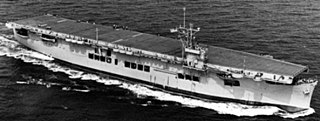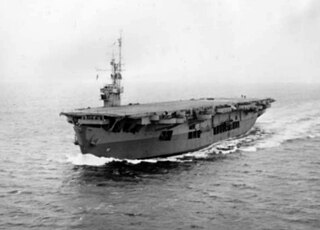
USS Sangamon (CVE-26) was a US Navy escort carrier of World War II.

USS Suwannee (CVE-27), was built as the civilian oiler Markay, in 1939, before being acquired by the US Navy, in 1941, and renamed Suwannee (AO-33), after the tradition of naming fleet oilers after rivers. In 1942, she was converted to a Sangamon-class escort carrier. Originally classified as an "Aircraft Escort Vessel", AVG-27, on 14 February 1942, she was reclassified an "Auxiliary Aircraft Carrier", ACV-27, 20 August 1942, before finally being classified as an "Escort Carrier", CVE-27, 15 July 1943. After the war, she was later classified an "Escort Helicopter Aircraft Carrier" and again redesignated, CVHE-27, 12 June 1955.

USS St. Lo (AVG/ACV/CVE–63) was a Casablanca-class escort carrier of the United States Navy during World War II. On 25 October 1944, St. Lo became the first major warship to sink as the result of a kamikaze attack. The attack occurred during the Battle off Samar, part of the larger Battle of Leyte Gulf.

USS White Plains (CVE-66) was a Casablanca-class escort carrier of the United States Navy. She was named after the 1776 Battle of White Plains.

USS Kitkun Bay (CVE-71) was the seventeenth of fifty Casablanca-class escort carrier built for the United States Navy during World War II. She was launched in November 1943, and transferred to the Navy and commissioned in December. She served in the Mariana and Palau Islands campaign, the Battle off Samar, in which she was the first ship to undergo kamikaze attack, and the Invasion of Lingayen Gulf, during which she was damaged by another kamikaze and forced to withdraw. Post-war, she participated in Operation Magic Carpet, repatriating U.S. servicemen from around the Pacific. She was decommissioned in April 1946, and sold for scrapping in November. Ultimately, she was broken up in early 1947.

USS Kalinin Bay (CVE-68) was a Casablanca-class escort carrier of the United States Navy.

USS Fanshaw Bay (CVE-70) was a Casablanca-class escort carrier of the United States Navy. She was named after Fanshaw Bay, located within Cape Fanshaw, of the Alexander Archipelago in the Territory of Alaska. The cape was given its name by Charles Mitchell Thomas, who was mapping the area, in 1887. Built for service during World War II, the ship was launched in November 1943, and commissioned in December, and served in support of the Mariana and Palau Islands campaign, the Battle off Samar, and the Battle of Okinawa. Postwar, she participated in Operation Magic Carpet. She was decommissioned in August 1946, when she was mothballed in the Pacific Reserve Fleet. Ultimately, she was sold for scrapping in September 1959.

USS Marcus Island (CVE-77) was the twenty-third of fifty Casablanca-class escort carriers built for the United States Navy during World War II. She was named after an engagement on 31 August 1943 over Minami-Tori-shima, known on American maps as Marcus Island. She was launched in December 1943, commissioned in January 1944, and she served in the Mariana and Palau Islands campaign, the Philippines campaign, as well as the Battle of Okinawa. She spent the majority of her World War II as a flagship for various escort carrier formations, serving as the headquarters for Rear Admiral William D. Sample and Felix Stump. During the Philippines campaign, she participated in the Battle off Samar, the largest naval engagement in history, and during the Battle of Mindoro, she had multiple near-brushes with Japanese kamikazes. Post-war, she participated in Operation Magic Carpet, repatriating U.S. servicemen from throughout the Pacific. She was decommissioned in December 1946, being mothballed in the Atlantic Reserve Fleet. Ultimately, she was broken up in 1960.

USS Ommaney Bay (CVE–79) was a Casablanca-class escort carrier of the United States Navy, which served during World War II. It was named after Ommaney Bay, located at the south end of Baranof Island, Alaska. Launched in late 1943 and commissioned in early 1944, the ship took part in the Mariana and Palau Islands campaign followed by several battles during the Philippines campaign in 1944 and early 1945. She was heavily damaged in a kamikaze attack and subsequently scuttled on 4 January 1945, with the loss of 95 men, including two men on board the destroyer escort Eichenberger who were killed by flying debris. She earned 2 battle stars whilst in service. In 2023, the Navy History and Heritage command announced that the wreck was located by "a combination of underwater survey and video information provided by Sea Scan Survey and DPT Scuba, two Australian diving firms, to positively identify the wreck."

USS Petrof Bay (CVE-80) was the twenty-sixth of fifty Casablanca-class escort carriers built for the United States Navy during World War II. She was named after Petrof Bay, which in turn was named in 1928 after Ivan Petroff, a Russian Alaskan who served as a special census agent for the 1880 United States census. The bay is located within Kuiu Island, which at the time was a part of the Territory of Alaska. The ship was launched in January 1944, commissioned in February, and served in support of the Mariana and Palau Islands campaign, the Philippines campaign, including the Battle off Samar, the Battle of Iwo Jima, and the Battle of Okinawa. She was decommissioned in July 1946, when she was mothballed in the Atlantic Reserve Fleet. Postwar, she participated in Operation Magic Carpet. Ultimately, she was broken up in September 1959.

USS Natoma Bay (CVE–62) was a Casablanca-class escort carrier of the United States Navy that served in the Pacific War during World War II. The carrier entered service in 1943 and participated in a series of operations in the South Pacific including the Philippines campaign, the Battle off Samar and the Battle of Okinawa. During the Okinawa battle, Natoma Bay was struck by a Japanese aircraft and heavily damaged, ending the ship's participation in the war. Once repaired, Natoma Bay was assigned to Operation Magic Carpet, the return of American soldiers from the Pacific theatre. Following the completion of the operation the escort carrier was decommissioned in 1946 and placed in reserve. In 1959, Natoma Bay was sold for scrap.

USS Savo Island (CVE-78) was the twenty-fourth of fifty Casablanca-class escort carriers built for the United States Navy during World War II. She was named to memorialize the U.S. casualties of the Battle of Savo Island, which was fought as part of the Guadalcanal campaign. The ship was launched in December 1943, commissioned in February 1944, and served as a frontline carrier throughout the Mariana and Palau Islands campaign and the Philippines campaign. During the Battle of Okinawa, she provided air cover for the replenishment carrier fleet. Postwar, she participated in Operation Magic Carpet, repatriating U.S. servicemen from throughout the Pacific. She was decommissioned in December 1946, when she was mothballed in the Atlantic Reserve Fleet. Ultimately, she was sold for scrapping in February 1960.

USS Trathen (DD-530) was a World War II-era Fletcher-class destroyer in the service of the United States Navy from 1943 to 1946 and 1951 to 1965.

USS John C. Butler (DE-339) was the lead ship of her class of destroyer escorts in the service with the United States Navy from 1944 to 1946. She was recommissioned between 1950 and 1957 and finally sunk as a target in 1971.

USS Helm (DD-388) was a Bagley-class destroyer in the United States Navy during World War II. She was named for Rear Admiral James Meredith Helm. Helm received 11 battle stars for her World War II service in the Pacific.

USS Halligan (DD-584) was a Fletcher-class destroyer of the United States Navy, named for Rear Admiral John Halligan, Jr. (1876–1934).

USS Stanly (DD-478) was a Fletcher-class destroyer in service with the United States Navy from 1942 to 1947. She was scrapped in 1972.

USS Twining (DD-540), a Fletcher-class destroyer, was a ship of the United States Navy named for Rear Admiral Nathan C. Twining (1869–1924).

USS Hunt (DD-674) was a Fletcher-class destroyer of the United States Navy, the second Navy ship named for William H. Hunt, Secretary of the Navy under President James A. Garfield.

USS Bryant (DD-665) was a Fletcher-class destroyer of the United States Navy, named for Rear Admiral Samuel W. Bryant (1877–1938).




















